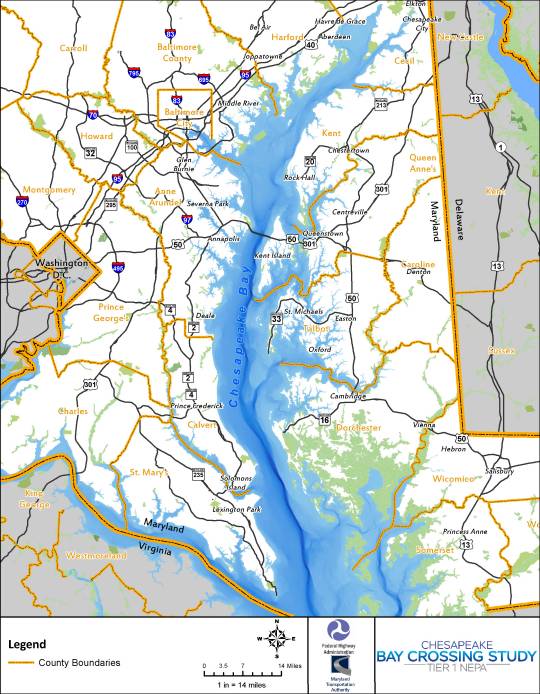 This official map shows the scope of the study for a new bay crossing structure.
This official map shows the scope of the study for a new bay crossing structure.Some might not think of it this way, but farmland is critical infrastructure akin to roads and bridges. It is the source of the food that sustains us. In addition, farmland provides open space, areas for recreation and habitat for wildlife. It also controls floods, suppresses fires, filters water and represents a vast carbon sink to mitigate and even help reverse climate change. Think Maryland's Eastern Shore.
As Americans—blessed with a remarkably productive agricultural landscape—we need to take a holistic vision of the future: one that acknowledges farmland as irreplaceable infrastructure we cannot afford to lose, supports environmentally sound farming practices and views farmers as the stewards of that land, worthy of our fervent support—because, at heart, what farmers do is for all of us.
That's why we are asking the Maryland Department of Transportation to consider farmland among the impacts in the Chesapeake Bay Crossing Study, which is exploring the feasibility of a third span across the Chesapeake Bay.
Farmland is essential infrastructure for Maryland's economy and efforts to combat climate change. It contributes a trillion dollars a year to the U.S. economy—more than $8.25 billion from Maryland alone, with $3 billion of added value. Farming is a critical economic engine for the Eastern Shore. Queen Anne's County alone boasts the most farmland acres and the largest farming economy in the state. Kent is the county with the largest percentage of land—76 percent—devoted to agriculture. Talbot and Caroline counties are similarly reliant on farming and farmland.
Importantly, well-managed farmland is a one-of-a-kind-tool in the fight against climate change and can help Maryland meet its 2020 goal to reduce greenhouse gases by 34.66 million tons. According to the 2017 annual report of the Maryland Commission on Climate Change, "Land conservation and sustainable management offers an important mechanism for mitigating and adapting to climate change…[helping] to avoid or diminish additional greenhouse gas emissions which would be associated with development."
Farmland loss is serious and accelerating. In May 2018, the American Farmland Trust released the most comprehensive assessment undertaken on the loss of U.S. farmland, "Farms Under Threat: The State of America's Farmland."
The report's key findings include:
• Between 1992 and 2012, almost 31 million acres of farmland were lost, 3 acres a minute, 175 acres per hour no longer available to produce food, fuel and fiber.
• Nearly twice the area of farmland was lost than was previously shown.
Development disproportionately occurred on agricultural lands, with 62 percent of all development occurring on farmland.
• Expanding urban areas accounted for 59 percent of the loss. Low-density residential development, or the building of houses on 1– to 20-acre parcels, accounted for 41 percent.
A subsequent report will analyze state-level data on past farmland conversion and the effectiveness of state-level farmland protection policies, including a state policy score card.
We must protect our most productive, versatile and resilient farmland.
Farms Under Threat identified that only about 17 percent of all the land in the continental United States is suited for intensive food and crop production. Maryland's Eastern Shore is blessed with a high percentage of prime farmland and must be protected—as much as 77 percent for counties like Kent and 55 percent for Queen Anne's counties.
Highway expansion is a significant driver of farmland conversion. While establishing a new bridge corridor or expanding a current one followed by the expansion of necessary highways may be the most obvious approach to addressing traffic congestion, there is growing consensus that this approach is ineffective.
Alternative solutions to traffic congestion have been proposed and should be considered—a regional transportation authority and system, managed demand strategies, and land use policies that promote compact growth and walkable communities to name just a few. These alternatives are in line with the Maryland Commission on Climate Change's recommendations, which emphasize the need to avoid or reduce future growth in vulnerable coastal areas (like the Chesapeake Bay region).
In the trust's analyses, development has been shown to follow highways and thus is a significant driver of farmland conversion. Development has unintended and often unobserved consequences on farming. It uproots farmers, pushes food production to more marginal lands and hampers the ability of remaining farmers to do what they do productively.
We need to save the land that sustains us. No farms, no food, no future.
John Piotti is president and CEO of American Farmland Trust. His views do not necessarily reflect those of the Bay Journal or somd.com.
More information on the Bay Crossing Study can be found at www.baycrossingstudy.com/


